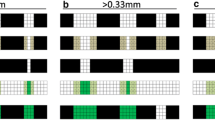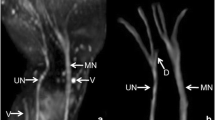Abstract
Objective
To study the feasibility of magnetic resonance cinematography of the fingers (MRCF) with comparison of image quality of different protocols for depicting the finger anatomy during motion.
Materials and methods
MRCF was performed during a full flexion and extension movement in 14 healthy volunteers using a finger-gating device. Three real-time sequences (frame rates 17–59 images/min) and one proton density (PD) sequence (3 images/min) were acquired during incremental and continuous motion. Analyses were performed independently by three readers. Qualitative image analysis included Likert-scale grading from 0 (useless) to 5 (excellent) and specific visual analog scale (VAS) grading from 0 (insufficient) to 100 (excellent). Signal-to-noise calculation was performed. Overall percentage agreement and mean absolute disagreement were calculated.
Results
Within the real-time sequences a high frame-rate true fast imaging with steady-state free precession (TRUFI) yielded the best image quality with Likert and overall VAS scores of 3.0 ± 0.2 and 60.4 ± 25.3, respectively. The best sequence regarding image quality was an incremental PD with mean values of 4.8 ± 0.2 and 91.2 ± 9.4, respectively. Overall percentage agreement and mean absolute disagreement were 47.9 and 0.7, respectively. No statistically significant SNR differences were found between continuous and incremental motion for the real-time protocols.
Conclusion
MRCF is feasible with appropriate image quality during continuous motion using a finger-gating device. Almost perfect image quality is achievable with incremental PD imaging, which represents a compromise for MRCF with the drawback of prolonged scanning time.


Similar content being viewed by others
References
Shellock FG, Mink JH, Deutsch A, Pressman BD. Kinematic magnetic resonance imaging of the joints: techniques and clinical applications. Magn Reson Q. 1991;7(2):104–35.
Quick HH, Ladd ME, Hoevel M, Bosk S, Debatin JF, Laub G, et al. Real-time MRI of joint movement with trueFISP. J Magn Reson Imaging. 2002;15(6):710–5.
Shellock FG, Mink JH, Deutsch AL, Foo TK, Sullenberger P. Patellofemoral joint: identification of abnormalities with active-movement, “unloaded” versus “loaded” kinematic MR imaging techniques. Radiology. 1993;188(2):575–8.
Muhle C, Brinkmann G, Brossmann J, Wesner F, Heller M. Kinematic MR imaging of the ankle—initial results with ultra-fast sequence imaging. Acta Radiol. 1997;38(5):885–9.
Boutin RD, Buonocore MH, Immerman I, Ashwell Z, Sonico GJ, Szabo RM, et al. Real-time magnetic resonance imaging (MRI) during active wrist motion—initial observations. PLoS One. 2013;8(12):e84004.
Nordmeyer-Massner JA, Pruessmann KP, Wyss M, Manoliu A, Hodler J, Andreisek G, et al. MR imaging of healthy knees in varying degrees of flexion using a stretchable coil array provides comparable image quality compared to a standard knee coil array. Eur J Radiol. 2016;85(3):518–23.
Tempelaere C, Pierrart J, Lefevre-Colau MM, Vuillemin V, Cuenod CA, Hansen U, et al. Dynamic three-dimensional shoulder MRI during active motion for investigation of rotator cuff diseases. PLoS One. 2016;11(7):e0158563.
Bayer T, Schweizer A, Muller-Gerbl M, Bongartz G. Proximal interphalangeal joint volar plate configuration in the crimp grip position. J Hand Surg Am. 2012;37(5):899–905.
Bayer T, Adler W, Schweizer A, Schoffl I, Uder M, Janka R. Evaluation of finger A3 pulley rupture in the crimp grip position-a magnetic resonance imaging cadaver study. Skelet Radiol. 2015;44(9):1279–85.
Klauser A, Frauscher F, Bodner G, Halpern EJ, Schocke MF, Springer P, et al. Finger pulley injuries in extreme rock climbers: depiction with dynamic US. Radiology. 2002;222(3):755–61.
Saito S, Suzuki Y. Biomechanics of the volar plate of the proximal interphalangeal joint: a dynamic ultrasonographic study. J Hand Surg Am. 2011;36(2):265–71.
Barkhausen J, Ruehm SG, Goyen M, Buck T, Laub G, Debatin JF. MR evaluation of ventricular function: true fast imaging with steady-state precession versus fast low-angle shot cine MR imaging: feasibility study. Radiology. 2001;219(1):264–9.
Abolmaali ND, Schmitt J, Schwarz W, Toll DE, Hinterwimmer S, Vogl TJ. Visualization of the articular disk of the temporomandibular joint in near-real-time MRI: feasibility study. Eur Radiol. 2004;14(10):1889–94.
Morales H, Cornelius R. Imaging approach to Temporomandibular joint disorders. Clin Neuroradiol. 2016;26(1):5–22.
Tomas X, Pomes J, Berenguer J, Quinto L, Nicolau C, Mercader JM, et al. MR imaging of temporomandibular joint dysfunction: a pictorial review. Radiographics. 2006;26(3):765–81.
Tomas X, Pomes J, Berenguer J, Mercader JM, Pons F, Donoso L. Temporomandibular joint soft-tissue pathology, II: nondisc abnormalities. Semin Ultrasound CT MR. 2007;28(3):205–12.
Lasalarie JC, Serfaty JM, Carre C, Messika-Zeitoun D, Jeannot C, Schouman-Claeys E, et al. Accuracy of contrast-enhanced cine-MR sequences in the assessment of left ventricular function: comparison with precontrast cine-MR sequences. Results of a bicentric study. Eur Radiol. 2007;17(11):2838–44.
Grothues F, Boenigk H, Graessner J, Kanowski M, Klein HU. Balanced steady-state free precession vs segmented fast low-angle shot for the evaluation of ventricular volumes, mass, and function at 3 Tesla. J Magn Reson Imaging. 2007;26(2):392–400.
Author information
Authors and Affiliations
Corresponding author
Ethics declarations
Conflict of interest
The authors declare that they have no conflict of interest.
Electronic supplementary material
(M4V 1383 kb)
(M4V 5917 kb)
(M4V 9296 kb)
(M4V 2081 kb)
(M4V 1024 kb)
(M4V 2588 kb)
(M4V 2305 kb)
Rights and permissions
About this article
Cite this article
Bayer, T., Adler, W., Janka, R. et al. Magnetic resonance cinematography of the fingers: a 3.0 Tesla feasibility study with comparison of incremental and continuous dynamic protocols. Skeletal Radiol 46, 1721–1728 (2017). https://doi.org/10.1007/s00256-017-2742-2
Received:
Revised:
Accepted:
Published:
Issue Date:
DOI: https://doi.org/10.1007/s00256-017-2742-2




